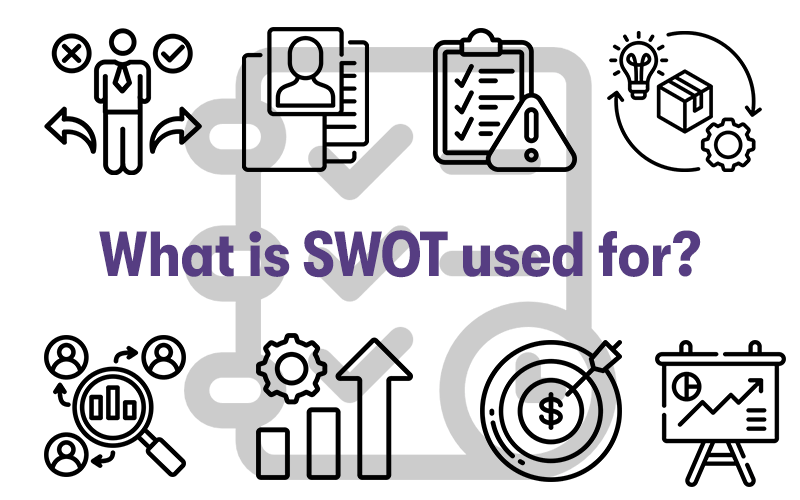Welcome to our guide on SWOT Analysis, a critical tool for strategic planning across various industries. By analysing Strengths, Weaknesses, Opportunities, and Threats, SWOT provides a straightforward framework for organisations and individuals to enhance their strategic decision-making.
SWOT analysis originated in the 1960s at Stanford Research Institute, developed by Albert Humphrey. It was designed to analyse corporate planning. The framework evaluates internal strengths and weaknesses alongside external opportunities and threats, providing a tool for strategic assessment and planning across businesses and helping guide long-term growth and competitive strategy.
SWOT Analysis helps not only in understanding your current position but also in envisioning future opportunities and planning how to achieve them.
This guide will detail the construction and application of SWOT Analysis, addressing its potential drawbacks. Our goal is to arm you with the insights to effectively use this strategic framework.
What is SWOT Analysis

SWOT Analysis is a strategic planning tool used to identify and understand the Strengths, Weaknesses, Opportunities, and Threats related to a business or project. It involves evaluating both internal and external factors that could impact the entity's ability to achieve its objectives. Here's a breakdown of each component:
Strengths
These are internal attributes and resources that support a successful outcome. Strengths are what the organisation does well or possesses that is advantageous compared to competitors, such as a strong brand reputation, unique technology, customer loyalty, or efficient distribution networks.
Weaknesses
These are internal factors that might hinder the achievement of an objective. Weaknesses are areas where the business or project lacks strength or is at a disadvantage compared to others, which might include insufficient research and development facilities, limited resource availability, skills shortages, or poor location.
Opportunities
External factors that the entity could exploit to its advantage. Opportunities refer to any favourable situation in the external environment that could be used to give it a competitive advantage, like market growth, lifestyle changes, technological advances, or regulatory changes.
Threats
External challenges that could cause trouble for the business or project. Threats involve any unfavourable situation, trend, or impending change in the external environment that might negatively affect the business, such as increased competition, adverse economic shifts, changing regulatory landscapes, or other risks.
The purpose of SWOT Analysis is to help organisations in strategic planning by translating these insights into actions that align with their strategic goals, enhance their strengths, address weaknesses, capitalise on opportunities, and mitigate threats. It is a versatile tool that can be used for overall business strategy sessions, competitor evaluation, marketing planning, and more.
What is SWOT used for?

SWOT Analysis is a versatile tool used for a wide range of purposes across different contexts, including business strategy, project management, personal development, and more. Its primary use is to help organisations or individuals make strategic decisions by providing a clear and comprehensive overview of the internal and external factors that could impact their objectives. Here are some specific applications of SWOT Analysis:
Strategic Planning
SWOT Analysis helps organisations identify their strategic position in the market and develop strategies that leverage their strengths, mitigate weaknesses, capitalise on opportunities, and protect against threats.
Business Expansion and Development
When considering expansion or exploring new markets, SWOT can uncover opportunities for growth and highlight potential challenges that may need to be addressed.
Improving Operations and Processes
By analysing internal strengths and weaknesses, companies can find areas for operational improvements, enhancing efficiency, and reducing costs.
Competitive Analysis
SWOT Analysis can be used to evaluate the competitive landscape by comparing an organisation's strengths and weaknesses with those of its competitors, helping to identify competitive advantages and threats.
Product Development
When developing new products or services, SWOT can help identify market needs, opportunities for innovation, and potential challenges in product development and launch.
Risk Management
By identifying external threats, organisations can develop strategies to prepare for and mitigate risks that could impact their operations or financial stability.
Personal and Career Development
Individuals can use SWOT Analysis for personal growth, career planning, and professional development by evaluating their strengths, weaknesses, opportunities for advancement, and potential obstacles.
Project Management
SWOT Analysis can assist in project planning and management by identifying the strengths and weaknesses of the project team, as well as opportunities and threats related to the project's success.
Marketing Strategy
It helps in crafting marketing strategies by identifying the strengths of the product or service, the weaknesses in marketing efforts, opportunities in the market, and threats from competitors.
Decision Making
SWOT Analysis provides a structured framework for evaluating options and making more informed decisions, whether for strategic business moves, career decisions, or project approaches.
The versatility of SWOT Analysis lies in its simplicity and the ability to apply it in various contexts, making it a fundamental tool for strategic thinking and planning.
How to do a SWOT Analysis
Using our SWOT Analysis Word Template effectively involves a systematic approach to gather, analyse, and interpret data related to your business or project's internal strengths and weaknesses, as well as external opportunities and threats. This guide will walk you through the steps to utilise the template fully, ensuring a comprehensive understanding and strategic planning process.
Step-by-Step Guide to Using the Free SWOT Analysis word Template or PDF SWOT Template:
Step 1: Preparation Phase
Gather Your Team: Assemble a diverse team from different departments or areas of your project/business to ensure a variety of perspectives.
Collect Preliminary Data: Gather existing reports, market research, financial data, and any relevant information that could inform your SWOT analysis.
Set Clear Objectives: Define what you want to achieve with the SWOT analysis. This could be general strategic planning, exploring a new initiative, or solving a specific problem.
Step 2: Analysis Phase
Strengths Analysis:
- Discuss and list the internal resources and attributes that contribute to achieving your objectives.
- Be specific and utilise data to support your points.
- Examples include unique resources, cost advantages, a strong brand, and successful R&D activities.
Weaknesses Analysis:
- Identify internal factors that could hinder your objective achievement.
- This requires honesty and openness to acknowledging areas of improvement.
- Look at areas like operational inefficiencies, financial constraints, and skill gaps.
Opportunities Analysis:
- Explore external chances for growth, improvement, or competitive advantage.
- Consider market trends, technological advancements, and changes in regulations.
- Assess how your strengths can be leveraged to capitalise on these opportunities.
Threats Analysis:
- Determine external challenges that could pose risks to your objectives.
- Include competitive landscape, economic downturns, and changes in consumer behaviour.
- Evaluate how your weaknesses may expose you to these threats and consider ways to mitigate them.
Step 3: Strategy Development Phase
Interpret and Prioritise Findings:
- Review all points listed in your SWOT analysis. Discuss their implications and identify which ones are critical to your objectives.
- Prioritise the issues based on their impact and urgency.
Develop Strategic Actions:
For each priority issue, brainstorm potential strategies or actions.
- Leverage Strengths: How can you use your strengths to take advantage of opportunities and counteract threats?
- Address Weaknesses: What steps can you take to improve or eliminate weaknesses to better meet challenges and seize opportunities?
- Capitalise on Opportunities: Determine specific actions to take full advantage of identified opportunities.
- Mitigate Threats: Develop strategies to protect against or minimise the impact of external threats.
Action Planning:
- Convert your strategies into actionable plans. Define clear, measurable objectives, assign responsibilities, set deadlines, and determine the resources needed.
Step 4: Implementation and Evaluation Phase
Implement Strategies: Execute the action plans, ensuring all team members understand their roles and the expected outcomes.
Monitor Progress: Establish a timeline for reviewing the progress of your strategies. Use key performance indicators (KPIs) relevant to your objectives to measure success.
Adapt and Adjust: Be prepared to adapt your strategies based on performance and external changes. Regular SWOT
Analysis updates can help you stay aligned with your strategic goals and respond effectively to new challenges and opportunities.
Tips for Effective SWOT Analysis
Engage Diverse Perspectives: Include team members from various parts of your organisation to ensure a comprehensive view of strengths, weaknesses, opportunities, and threats.
Be Objective: Encourage honesty and openness in discussions. Acknowledge weaknesses and threats without bias to ensure accurate analysis.
Use Data and Examples: Support your points with data, examples, and evidence. This will make your analysis more credible and actionable.
Focus on Actionability: Prioritise issues and opportunities that are within your control and can be addressed with specific actions. Avoid focusing too much on uncontrollable factors.
Review and Update Regularly: The business environment is constantly changing. Regularly revisit your SWOT analysis to adjust your strategies to new information or market conditions.
By following these steps and tips, you can maximise the effectiveness of your SWOT analysis, leading to insightful strategic planning and improved decision-making. This process not only helps in identifying the best paths forward but also in uniting your team around common goals and strategies.
The Benefits of Doing a SWOT Analysis

Conducting a SWOT analysis offers numerous benefits for businesses, organisations, and even individuals looking to evaluate and enhance their strategic planning processes. Here are some of the key advantages:
Comprehensive Overview
Provides a structured method to examine both internal and external factors affecting the entity, offering a holistic view of the current situation.
Strengthens Decision-Making
By providing a clear snapshot of strengths, weaknesses, opportunities, and threats, SWOT analysis supports more informed and strategic decision-making processes.
Facilitates Strategic Planning
Acts as a foundation for strategic planning by linking the entity's capabilities to the competitive environment in which it operates, guiding the direction for future strategies and objectives.
Encourages Proactivity
Encourages organisations to anticipate future business scenarios and proactively manage change rather than react to external pressures.
Promotes Team Collaboration
Engaging different parts of the organisation in the SWOT analysis process can foster teamwork and collaboration as it requires input from various perspectives.
Resource Allocation
Helps in prioritising actions and allocating resources more effectively by highlighting areas of strength that can be leveraged and weaknesses that need attention.
Competitive Advantage
Can uncover competitive advantages or positions that the organisation can exploit to differentiate itself in the marketplace.
Flexibility and Simplicity
The SWOT analysis framework is simple to understand and can be applied to a wide range of entities (such as businesses, projects, or individuals) and scenarios, making it a flexible tool.
Performance Improvement
By regularly conducting SWOT analysis, organisations can continuously monitor their performance and adapt their strategies to improve efficiency, productivity, and profitability.
Risk Management
Helps in identifying and assessing potential risks in the external environment, facilitating better risk management strategies.
The effectiveness of a SWOT analysis largely depends on the quality and depth of the data collected and the willingness of the participants to engage in honest, critical analysis. When conducted thoroughly, it can lead to significant insights that propel strategic growth and enhance competitive positioning.
SWOT analysis Limitations

While SWOT analysis is a widely used tool for strategic planning due to its simplicity and versatility, it also has several limitations that users should be aware of:
Over-Simplification
SWOT analysis provides a high-level overview, which can sometimes lead to the oversimplification of complex issues. This simplification might overlook deeper problems or opportunities within an organisation or a project.
Subjectivity
The process can be highly subjective, with different participants potentially having contrasting views on what constitutes a strength, weakness, opportunity, or threat. This subjectivity can affect the accuracy and usefulness of the analysis.
Lack of Prioritisation
SWOT does not inherently prioritise issues; all factors are listed without considering their relative importance or impact. Without careful interpretation, critical issues might not receive the attention they deserve.
No Direct Link to Strategy Implementation
While SWOT analysis helps identify strategic factors, it doesn't provide a direct pathway for strategy implementation or suggest how to leverage strengths and opportunities or address weaknesses and threats.
Static Analysis
The SWOT framework provides a snapshot in time and may not account for future changes in the external environment or the internal dynamics of the organisation. It can quickly become outdated if not regularly reviewed and updated.
May Ignore External Factors
There's a risk that the analysis might focus too much on internal factors (strengths and weaknesses) at the expense of adequately considering external factors (opportunities and threats) or vice versa.
Analysis Paralysis
In some cases, the process of conducting a SWOT analysis can lead to an overwhelming amount of information, making it difficult to move from analysis to action. This "analysis paralysis" can delay decision-making and strategic action.
Resource Intensive
Conducting a thorough and comprehensive SWOT analysis can be time-consuming and resource-intensive, particularly for small businesses or individual projects with limited capacity.
Interconnectivity of Factors
SWOT analysis treats strengths, weaknesses, opportunities, and threats as discrete elements without always recognising the complex interrelationships between these factors.
Risk of Confirmation Bias
There's a tendency to use SWOT analysis to confirm pre-existing beliefs or assumptions rather than challenging them. This confirmation bias can limit the effectiveness of the analysis.
Despite these limitations, SWOT analysis remains a useful starting point for strategic planning. It can provide valuable insights when used judiciously and in conjunction with other analytical tools and frameworks that can help address its shortcomings, such as PESTEL analysis for a more comprehensive external review or TOWS matrix for directly linking SWOT findings to strategic actions.
Final Notes of Free SWOT analysis Template Word
Our guide of SWOT analysis has provided a structured approach to strategic planning by identifying strengths, weaknesses, opportunities, and threats. We detailed a comprehensive template and explained its practical application, guiding users through effective strategic assessment.
While SWOT analysis is versatile, it also has limitations, such as potential oversimplification and a static view. However, when used wisely alongside other tools, it can significantly enhance informed decision-making and strategic growth.
Remember, regularly update and reassess your SWOT matrix. The business environment is dynamic, and factors that influence your organisation can change rapidly. By periodically revisiting your SWOT analysis, you ensure that your strategies remain relevant and effective and you can quickly adapt to emerging opportunities and threats.



